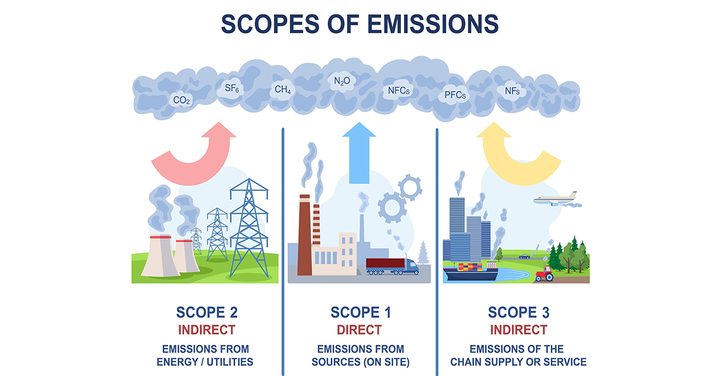
What Are Scope 3 Emissions & Where Do They Fall in Your Value Chain?
As social norms have evolved, automation of daily tasks has changed everything. Manufacturing plants in areas with low-cost labour have supplanted handmade, local products. As a result, transportation of raw materials and finished goods have resulted in more carbon emissions.
Many governments and companies have committed to better regulation, creating a new sustainability-driven focus for shippers and carriers. Shifting consumer behaviors and increased regulations are pushing scope 3 emissions to new visibility and the focus of not only how something is produced but how it’s transported. Today, tracking scope 3 emissions is required and best practice for all companies.
When asking, “what are Scope 3 emissions?,” it’s imperative to realise that scope 1 and 2 emissions could be the Scope 3 emissions for another organisation. Unless you are the contracting party with an ocean carrier, the emissions move further away from your direct control. In other words, if working with a forwarder, the forwarder may be responsible for understanding the impacts of its direct emissions from a secondary party. Still, those emissions are tertiary to your company. Scope 3 emissions are also known as value-chain emissions for this reason. The extensive supply chain full of multiple entities makes it challenging to know when to report those emissions and avoid double counting them.
What Are Scope 3 Emissions, and Why Is Tracking Them Important?
Carbon emissions fall under three tiers or categories for calculating CO2 emissions. It is in some countries and regions to record and report Scope 1 and 2 emissions, including direct emissions from company facilities and vehicles and indirect emissions, put off by purchased energy usage for the buildings or vehicles. However, it gets more confusing as activity occurs further away from your control, especially considering how organisations could reduce emissions.
As noted by the Smart Freight Centre, innovation to track and accurately measure the “carbon content of energy, fleet energy efficiency, asset utilisation, freight transport modes, and freight demand…can reduce emissions by at least 80% by 2050.”
For example, a paper good’s manufacturer’s transportation and distribution sourced through a 3PL would largely fall within Scope 3; however, if the 3PL owns assets used for inland transport, emissions would fall in another scope for that 3PL.
Shippers or forwarders who track emissions accurately can determine the least emission-producing shipping mode or lane, directly impacting carbon emission control.
Where Do Ocean Emissions Rank in the Grand Scheme of Things?
Today nearly 90% of products are shipped worldwide by sea, showcasing that the shipping industry is the foundation for the global value chain. The Asia-Pacific region sees the most international freight carriers, with China, India, Japan, and South Korea contributing to nearly every avenue of global trade.
Dr. Kelvin Leung shared with the World Ocean Initiative that “The Fourth Greenhouse Gas study conducted by the International Maritime Organisation (IMO) found that global ocean freight emitted 1,076m tonnes of carbon dioxide in 2018. Unaddressed, industry emissions could increase between 50% and 250%, as demand for freight shipping may expand threefold by 2050. Therefore, there is an urgent need to reduce greenhouse gas (GHG) emissions and pave the way for a cleaner, more sustainable sea-freight solutions.”
Ocean carriers are an inevitable driver of global GHG emissions despite the fuel efficiency of sea freight over other transportation forms. Furthermore, there are a limited number of ocean carriers, meaning they reside in a part of the value chain that almost exclusively produces Scope 3 emissions for other value chain parties.
Also, emissions will vary depending on the number of stops a vessel makes between two destinations, such as the possible stop-off in Greece in the Shanghai to Rotterdam route below:
Ocean transport isn’t like other means of transportation. For example, there is no specific set part of the ocean where the ship always moves, and depending on conditions, like the weather, ships may spend more or less fuel. In other instances, the shipment journey needs to move into a more multimodal approach to achieve emissions reductions, seeing which inland moves are the most sustainable and where or how those moves affect your carbon footprint.
Answer “What Are Scope 3 Emissions” With Better Data and Network Views From Searoutes
Business-to-business network partners have communicated that sustainability matters from end to end. Still, it’s not enough to simply pluck an average of an average from the air and report it as emissions totals. The trick is figuring out the exact emissions and knowing if double-counting occurs in the value chain. Lowering emissions levels cannot be treated as an afterthought any longer. However, much ocean emission recording and reporting can be difficult without the right tools. Searoutes is a Smart Freight Centre accredited company specialising in global sustainability logistics. To learn how to choose the greenest carriers and calculate the most eco-friendly routes on ocean and land, request a demo with Searoutes today.